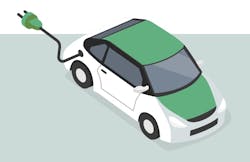Back in 2011, I was told that the collision repair business would circle the drain in five to seven years. I was very disheartened at the time but here we are, eight years later, it’s 2019 and, as near as I can tell, the collision repair industry is still going strong. Now the question is, what’s in store for us in the next five to seven years?
In last month’s column, we looked at some of the predictions that ride-sharing and ride-hailing apps will be a leading cause in the decline of vehicle ownership, as well as the advent of autonomous driving vehicles and its impact on our industry.
In 2019 and going forward, I believe there are several trends and challenges that collision repair operators need to be aware of and, in some cases, for which they need to be begin being prepared. Some of these trends come to us by way of wild predictions from people who act like they are “in the know.” These trends include plug-in electric vehicles, an increased proliferation of advanced driver-assist systems, telematics with connected cars and infrastructure, artificial intelligence–based estimating and claims settlement, and the fact that American-built sedans and coupes are falling out of favor with consumers. We will talk about one of these predictions today and, in future columns, we will talk about some of the other technologies and trends that may or may not affect our industry.
Plug-in electric vehicles (both battery only and hybrid) are steadily becoming more popular globally and domestically. Global cumulative sales of these vehicles reached the 4 million mark in September 2018. Roughly 2 million of that number are found in China, 1 million are registered in Europe and the remaining 1 million are driven in the United States. Interestingly, one-half of the 1 million PEVs in the U.S. are registered in California. So, what does this mean in the big picture? At first glance, not much.
Because PEVs in the U.S. only account for roughly 1.2 percent of total vehicle sales, if the market share grows at recent historical rates, the net result would be that about 4 percent of vehicle sales five years from now will be represented by electric vehicles. There are a few major wild cards to this prediction that could accelerate or hinder the growth of PEV market share. One is the fact that many European OEMs have declared that they will be rapidly phasing out internal combustion engine propulsion systems in favor of electric motor–powered vehicles. Volvo (which, by the way, is owned by a Chinese corporation) has stated that, by 2030, all vehicles they produce will be plug-in electric. Jaguar/Land Rover (which, by the way, are a subsidiary of an Indian auto group) have announced a similar timeline for production of electric vehicles. Buyers who are fond of European vehicles will, by default, become owners of PEVs, but we are looking at least 10 years out before this happens.
Another wild card is the fact that there are some start-up rivals to Tesla that may compete for some of Tesla and electric vehicle market share. In spite of some growing pains, Tesla has done a remarkable job of going from an idea to an actual producer of cool vehicles that people want.
The final wild card to the growth of PEV market share has to do with the aging infrastructure of our power supplies and the sources of electric power. Summers in southern California can be brutally hot and our business and homes are equipped with air conditioners to provide some relief from the heat. Unfortunately, our electrical utility companies don’t have the infrastructure to handle the load demands and we often experience brownouts during peak use hours. Millions of residents have devices installed on their air conditioners that allow the utilities to turn off the A/C units when demand is too high. When I think about this, it makes me wonder how the electric utility companies are going to be able to handle a few million people plugging in their electric cars for recharging in the evening. I know that some people like to tease Californians about their stances on all things related to the environment, but there is a pretty strong consensus here, and in some other states, that our power needs to come from clean sources such as solar and wind. Environmentalists dislike the idea of hydro-electric power because the construction of dams is just as harmful to the environment. No matter where you sit on this debate, the fact is, California and many other states have begun to legislate their way into only allowing clean energy sources in the future.
I didn’t want to throw a bunch of data at you, but I’ve done the research and I’m not convinced that electric vehicles will dominate the marketplace anytime soon. Nevertheless, in some major metropolitan markets, it behooves collision repair shops to be prepared to handle the repairs to these vehicles. If you’re not prepared, please just pass on the repairs for the safety of your team—and the integrity of your business. If you are taking these vehicles in for repair, read, then re-read and understand the latest OEM repair instructions and guidelines.
About the Author

Steve Morris
The late Steve Morris was the regional director for Classic Collision in California (formerly Pride Collision Centers). He was an Accredited Automotive Manager (AAM) and ASE-certified master technician. Morris died April 22, 2022, at the age of 63 of complications following surgery.
